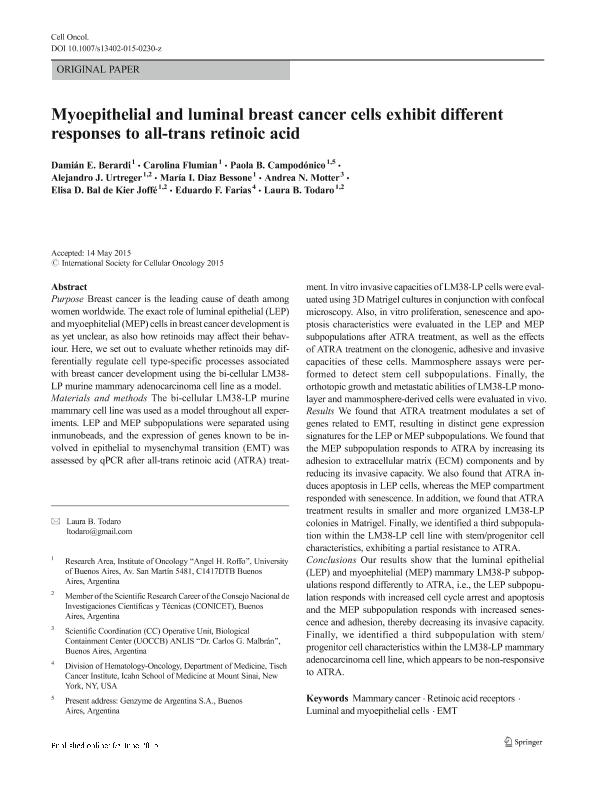Mostrar el registro sencillo del ítem
dc.contributor.author
Berardi, Damian Emilio

dc.contributor.author
Flumian, Carolina

dc.contributor.author
Campodónico, Paola Bernadette

dc.contributor.author
Urtreger, Alejandro Jorge

dc.contributor.author
Díaz Bessone, María Inés

dc.contributor.author
Motter, Andrea N.
dc.contributor.author
Bal, Elisa Dora

dc.contributor.author
Farias, Eduardo F.
dc.contributor.author
Todaro, Laura Beatriz

dc.date.available
2018-03-19T21:10:40Z
dc.date.issued
2015-08
dc.identifier.citation
Berardi, Damian Emilio; Flumian, Carolina; Campodónico, Paola Bernadette; Urtreger, Alejandro Jorge; Díaz Bessone, María Inés; et al.; Myoepithelial and luminal breast cancer cells exhibit different responses to all-trans retinoic acid; Kluwer Academic/Plenum Publ; Cellular Oncology; 38; 4; 8-2015; 289-305
dc.identifier.issn
2211-3428
dc.identifier.uri
http://hdl.handle.net/11336/39303
dc.description.abstract
Purpose: Breast cancer is the leading cause of death among women worldwide. The exact role of luminal epithelial (LEP) and myoephitelial (MEP) cells in breast cancer development is as yet unclear, as also how retinoids may affect their behaviour. Here, we set out to evaluate whether retinoids may differentially regulate cell type-specific processes associated with breast cancer development using the bi-cellular LM38-LP murine mammary adenocarcinoma cell line as a model. Materials and methods: The bi-cellular LM38-LP murine mammary cell line was used as a model throughout all experiments. LEP and MEP subpopulations were separated using inmunobeads, and the expression of genes known to be involved in epithelial to mysenchymal transition (EMT) was assessed by qPCR after all-trans retinoic acid (ATRA) treatment. In vitro invasive capacities of LM38-LP cells were evaluated using 3D Matrigel cultures in conjunction with confocal microscopy. Also, in vitro proliferation, senescence and apoptosis characteristics were evaluated in the LEP and MEP subpopulations after ATRA treatment, as well as the effects of ATRA treatment on the clonogenic, adhesive and invasive capacities of these cells. Mammosphere assays were performed to detect stem cell subpopulations. Finally, the orthotopic growth and metastatic abilities of LM38-LP monolayer and mammosphere-derived cells were evaluated in vivo. Results: We found that ATRA treatment modulates a set of genes related to EMT, resulting in distinct gene expression signatures for the LEP or MEP subpopulations. We found that the MEP subpopulation responds to ATRA by increasing its adhesion to extracellular matrix (ECM) components and by reducing its invasive capacity. We also found that ATRA induces apoptosis in LEP cells, whereas the MEP compartment responded with senescence. In addition, we found that ATRA treatment results in smaller and more organized LM38-LP colonies in Matrigel. Finally, we identified a third subpopulation within the LM38-LP cell line with stem/progenitor cell characteristics, exhibiting a partial resistance to ATRA. Conclusions: Our results show that the luminal epithelial (LEP) and myoephitelial (MEP) mammary LM38-P subpopulations respond differently to ATRA, i.e., the LEP subpopulation responds with increased cell cycle arrest and apoptosis and the MEP subpopulation responds with increased senescence and adhesion, thereby decreasing its invasive capacity. Finally, we identified a third subpopulation with stem/progenitor cell characteristics within the LM38-LP mammary adenocarcinoma cell line, which appears to be non-responsive to ATRA.
dc.format
application/pdf
dc.language.iso
eng
dc.publisher
Kluwer Academic/Plenum Publ

dc.rights
info:eu-repo/semantics/openAccess
dc.rights.uri
https://creativecommons.org/licenses/by-nc-sa/2.5/ar/
dc.subject
Emt
dc.subject
Luminal And Myoepithelial Cells
dc.subject
Mammary Cancer
dc.subject
Retinoic Acid Receptors
dc.subject.classification
Bioquímica y Biología Molecular

dc.subject.classification
Medicina Básica

dc.subject.classification
CIENCIAS MÉDICAS Y DE LA SALUD

dc.title
Myoepithelial and luminal breast cancer cells exhibit different responses to all-trans retinoic acid
dc.type
info:eu-repo/semantics/article
dc.type
info:ar-repo/semantics/artículo
dc.type
info:eu-repo/semantics/publishedVersion
dc.date.updated
2018-03-19T17:25:28Z
dc.identifier.eissn
2211-3436
dc.journal.volume
38
dc.journal.number
4
dc.journal.pagination
289-305
dc.journal.pais
Países Bajos

dc.journal.ciudad
Amsterdam
dc.description.fil
Fil: Berardi, Damian Emilio. Universidad de Buenos Aires. Facultad de Medicina. Instituto de Oncología "Ángel H. Roffo"; Argentina. Consejo Nacional de Investigaciones Científicas y Técnicas; Argentina
dc.description.fil
Fil: Flumian, Carolina. Universidad de Buenos Aires. Facultad de Medicina. Instituto de Oncología "Ángel H. Roffo"; Argentina. Consejo Nacional de Investigaciones Científicas y Técnicas; Argentina
dc.description.fil
Fil: Campodónico, Paola Bernadette. Universidad de Buenos Aires. Facultad de Medicina. Instituto de Oncología "Ángel H. Roffo"; Argentina. Consejo Nacional de Investigaciones Científicas y Técnicas; Argentina
dc.description.fil
Fil: Urtreger, Alejandro Jorge. Universidad de Buenos Aires. Facultad de Medicina. Instituto de Oncología "Ángel H. Roffo"; Argentina. Consejo Nacional de Investigaciones Científicas y Técnicas; Argentina
dc.description.fil
Fil: Díaz Bessone, María Inés. Universidad de Buenos Aires. Facultad de Medicina. Instituto de Oncología "Ángel H. Roffo"; Argentina. Consejo Nacional de Investigaciones Científicas y Técnicas; Argentina
dc.description.fil
Fil: Motter, Andrea N.. Dirección Nacional de Instituto de Investigación. Administración Nacional de Laboratorio e Instituto de Salud “Dr. C.G. Malbrán”; Argentina
dc.description.fil
Fil: Bal, Elisa Dora. Universidad de Buenos Aires. Facultad de Medicina. Instituto de Oncología "Ángel H. Roffo"; Argentina. Consejo Nacional de Investigaciones Científicas y Técnicas; Argentina
dc.description.fil
Fil: Farias, Eduardo F.. Icahn School of Medicine at Mount Sinai; Estados Unidos
dc.description.fil
Fil: Todaro, Laura Beatriz. Universidad de Buenos Aires. Facultad de Medicina. Instituto de Oncología "Ángel H. Roffo"; Argentina. Consejo Nacional de Investigaciones Científicas y Técnicas; Argentina
dc.journal.title
Cellular Oncology
dc.relation.alternativeid
info:eu-repo/semantics/altIdentifier/doi/http://dx.doi.org/10.1007/s13402-015-0230-z
dc.relation.alternativeid
info:eu-repo/semantics/altIdentifier/url/https://link.springer.com/article/10.1007%2Fs13402-015-0230-z
Archivos asociados
